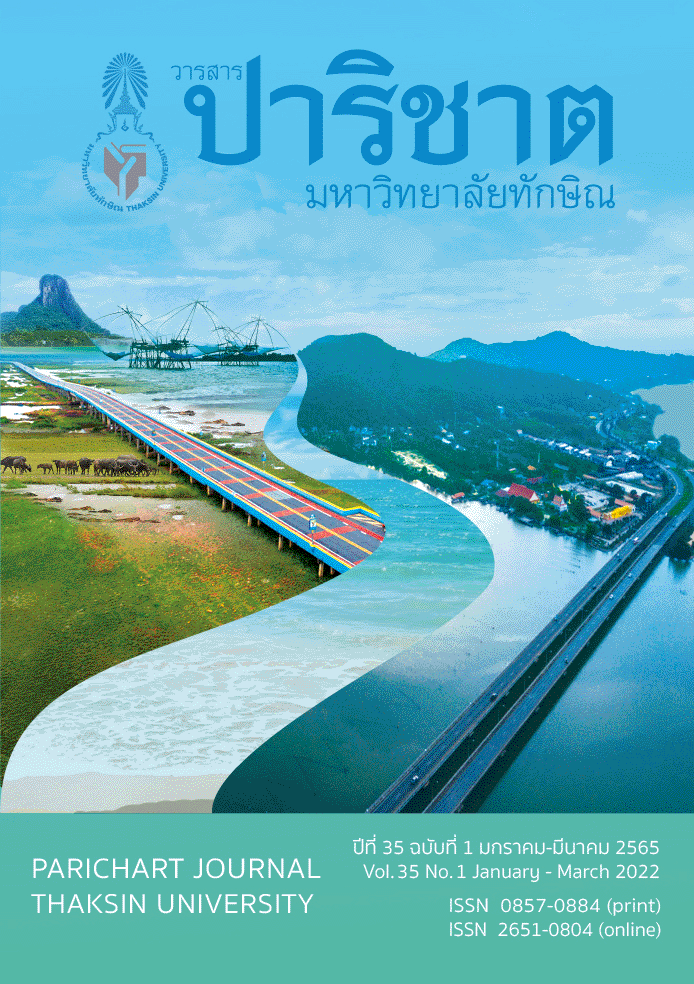From Human’s Attitude Towards Scars to Innovative Bio Textile Substitute Derived from Soil to Create Garments for the Future
Main Article Content
Abstract
The objective of this research article is to study and carry out research in the biological innovation of the substitute textile derived from soil and through series of improved material efficiency, and we were able to produce future costume prototype that have been resulted from the 3 elements of conceptual framework. The 3 elements are firstly to create innovation based on scientific knowledge through the use of synthetic bio fiber processing and synthetic brown pigmentation that resemble melanin cell in human skin according to research in the skin of the Thai population. Secondly, it is to add value to the natural resource base which focuses on a circular production process that is environmentally friendly. Lastly, it is to exhibit the empirical design aesthetic through using the substitute textile that resembles the human skin color. If one is taking a closer look at the substitute textile, one would consider it to be wounds or operation scars. These permanent marks or scars are either the evidence of sadness and embarrassment feelings or the safety and survival. The researcher has applied this concept into clothing design by using substitute textile produced from soil. This new form of textile is meant to portray the true meaning of beauty caused by imperfections. These imperfections are the symbol of life, expressing the communication of rounds of existence between nature and human.
Article Details

This work is licensed under a Creative Commons Attribution-NonCommercial-NoDerivatives 4.0 International License.
References
Jitbantao, T (2017). Psychoanalysis Theory of Personality. Journal of Social Sciences, 10(2), 276-278. Retrieved December 29, 2020, from https://so04.tci-thaijo.org/index.php/social_crru/article/view/134234. (In Thai)
Stand Up To Cancer. (2017). Cancer Research UK. Retrieved January 31, 2021, from https://www.standuptocancer.org.uk/photo-series-cancer-diagnosis-defiance.
Alex, P. (2020, May 5). In the Era of Filters, Dispelling the Stigma of Scarred Skin Is More Important Than Ever. Voque. Retrieved Retrieved January 31, 2021, from https://www.vogue.co.uk/beauty/article/dispelling-scar-stigma.
Strohminger, N., Knobe, J., & Newman, G. (2017). The True Self: A Psychological Concept Distinct from the Self. Sage Journal, 12(4), 551-560. doi/10.1177/1745691616689495.
Brady, E. (2009). Environmental Aesthetics. In Encyclopedia of Environmental Ethics and Philosophy, edited by Callicott, J. B., and Frodeman, R., 1, 313-321. Retrieved February 8, 2021, from https://iseethics.files.wordpress.com/2013/01/brady-emilyenvironmental-aesthetics.pdf.
Justyna, M.D., Monika, Z., Beata, K., Krzysztof, F., & Izabela, S. (2015). Melanin-Like Pigment Synthesis by Soil Bacillus weihenstephanensis Isolates from Northeastern Poland. Plos One. doi.org/10.1371/journal.pone.0125428.
National Science and Technology Development Agency. (2020). The 12th National Economic and Social Development Plan. Retrieved December 29, 2020, from https://www.nstda.or.th/th/nstda-knowledge/11428-strategy-5.
Australian Radiation Protection and Nuclear Safety Agency. (2017). Fitzpatrick Skin Type. Retrieved Retrieved January 16, 2019, from https://www.arpansa.gov.au/sites/default/files/legacy/pubs/RadiationProtection/FitzpatrickSkinType.pdf?acsf_files_redirect.
D'Orazio, J., Jarrett, S., Amaro-Ortiz, A., & Scott, T. (2013). UV radiation and the skin. International journal of molecular sciences, 14(6), 12222–12248. doi.org/10.3390/ijms140612222.
National Science and Technology Development Agency. (2020). The 12th National Economic and Social Development Plan. Retrieved December 29, 2020, from https://www.nstda.or.th/th/nstda-knowledge/11428-strategy-5.


